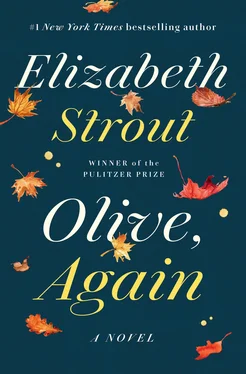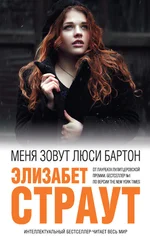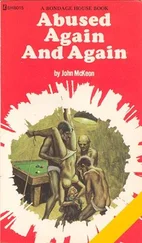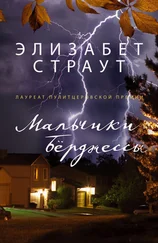
The Ringrose house also had a loneliness about it. But it was a different flavor than Bertha Babcock’s place, and the house was smaller—it was a Cape on River Road, and it had on the front of it a small board that said 1742—and also somehow cleaner; Kayley didn’t have to work so hard. The first day she was there, Mrs. Ringrose told her she was to clean the logs in the fireplace each week with a cleaning fluid that Kayley was to put in a pail of warm water; the logs were birch, and their bark was a whitish gray. And she was to clean the wooden floors on her hands and knees, Mrs. Ringrose said, and Kayley didn’t care; she was young, it wasn’t the endless kitchen of the Babcock home. In the living room on a table all by itself was a wooden model of the Mayflower. Kayley was not to touch this, Mrs. Ringrose said that first day, holding up her finger. “Do. Not. Touch.” Then she told Kayley how she was a direct descendant of Myles Standish, who had come over on this ship, and if you looked at it—Mrs. Ringrose peered down at the model—you could see where the people stayed, and Kayley murmured, “Oh yeah,” although she thought of her father then, and how, when he was sick in the back room, she would watch the movie with him about Michael Collins and the green tank of the English that came into Croke Park and started shooting all the Irish people. Kayley stepped back from Mrs. Ringrose; being so close to her allowed Kayley to see the patches of pink scalp through her white hair; it gave Kayley that sense of nausea again.
—
But also on that first day—it was the strangest thing—Mrs. Ringrose made Kayley try on her wedding gown. The gown was yellow in places, and spread out on Mrs. Ringrose’s bed. Mrs. Ringrose had a separate bedroom and bathroom from her husband. “Just try it on, Kayley. You’re about the size I was when I got married, and I would like to see this gown on someone.” She gave a little nod. “Come on now,” she said.
Kayley looked behind her, then back at Mrs. Ringrose. Slowly she unbuttoned her blouse, and Mrs. Ringrose kept standing there watching her, so Kayley took her blouse off, and then she unzipped her jeans and took them off too, after slipping off her sneakers. She stood in her underpants and her bra in front of this woman as a milky sunlight came through the windows of the bedroom; tiny goosebumps went over her arms and legs. Mrs. Ringrose held the dress above Kayley’s head, and it slipped down over her body, fitting her easily.
Mrs. Ringrose took her glasses off and wiped her eyes with her other hand. There was water still on her cheeks when she put her glasses back on.
“Now listen,” Mrs. Ringrose said, touching Kayley’s shoulder. “I’ve started a group at our church, and it’s called the Silver Squares. There’s already one group called the Golden Circle, but they’re old, and so I have started the Silver Squares and we’re going to have a fashion show in June, and I would like you to play the piano for it and wear my wedding dress.”
With the woman still watching her, Kayley got into her own clothes again.
—
Except for Kayley’s first time at the Ringroses’, Mrs. Ringrose was never there. “I’ll be off at the Silver Squares,” she had said. Kayley got the key from under the mat and let herself in, as she had been instructed to do. A ten-dollar bill was always left on the kitchen table for her.
But the Ringroses’ house really depressed Kayley in a powerful way.
For example: Mr. Ringrose’s bathroom was designed to look like an outhouse. There was a dark green painted barrel around a flush toilet, so it looked like you were going to sit on a hole. Rough wooden planks were on the walls. Kayley had never spoken to Mr. Ringrose; he was not there when she cleaned, and she knew who he was only because she’d seen him around town with Mrs. Ringrose: He was tall, old, white-haired; for years he had worked in Portland at some history museum, but he had long been retired. There was no sink in his bathroom; just those barn boards with the dark green barrel in the middle. Mrs. Ringrose’s bathroom was normal, white porcelain with a sink and a vanity table with her hairbrush on it and hairpins.
In the living room, the couch was small and tightly upholstered. The seat rounded up into a mound, and when Kayley sat on it she felt she might almost slip off. The chairs were the same. The upholstery was a deep rose color, and on the dark green walls were paintings of people that looked like weird dolls, they looked a little bit like grown-ups, except for how short they were, and they wore white hats and dresses that were from a different era; these pictures Kayley could not stand.
She could not stand them.
“How does she even know you play the piano?” asked Christine Labbe. She and Kayley were walking on the sidewalk, close to the center of town by the doughnut shop, and Christine was eating a doughnut that had cinnamon all over it. Christine’s eyes had dark blue liner around them, and part of it was smudged.
“I don’t know.” Kayley turned to look at the cars going by. “Maybe she heard me playing that piano they have in the gym. I don’t know how she knows.”
Christine said, “She’s creepy. Her husband’s creepy too. Dressing up like stupid Pilgrims every year and talking about that stupid fucking Mayflower ship her ancestors came over on. Reciting that stupid Longfellow poem ‘The Courtship of Miles Standish’ while kids yawn their fucking heads off.”
“You should see their house,” Kayley said, and she described Mr. Ringrose’s bathroom.
Christine looked at her and said, “Jesus Holy Christ.” Then Kayley touched her eye to show Christine that her makeup was smudged, and Christine shrugged and took another bite of her doughnut.

On Saturday afternoon Kayley rode her bicycle to the nursing home out past the bridge where Miss Minnie was. It was cold in mid-March, but there was very little snow, and Kayley’s bicycle bumped over twigs that had fallen onto the sidewalk; her hands were cold because she wore no gloves. Miss Minnie used to live in the apartment above the one Kayley lived in now with her mother; Miss Minnie had lived there for years, and she was the first person Kayley had cleaned for. The old woman was tiny, with enormous dark eyes, and Kayley had been astonished at the grime, especially in the kitchen, that had built up over time. And so Kayley scrubbed and scrubbed while Miss Minnie peered into the doorway and said, “Oh, what a lovely job you’re doing, Kayley!” Miss Minnie would clap her hands, she was that excited at Kayley’s work, and Kayley loved her for this. Miss Minnie always gave Kayley a glass of orange juice when she was done, and Miss Minnie would sit across the table from her, leaning forward toward Kayley, and ask questions about her school and her friends; no one had asked Kayley about these things since her father died.
After Miss Minnie had her stroke last fall, Kayley went to visit her in the nursing home, even though the place was dark and smelled bad. Miss Minnie would thank her many times for coming. “It’s okay,” Kayley would say, “I like seeing you,” and after the first few visits she gave Miss Minnie a kiss when she left, and the old lady’s enormous dark eyes would glow.
Читать дальше













